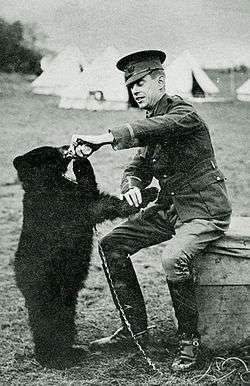Harry Colebourn

Harry D. Colebourn (April 12, 1887–September 24, 1947) was a Canadian veterinarian and soldier with the Royal Canadian Army Veterinary Corps best known for donating a bear cub named "Winnie" (short for "Winnipeg") to the London Zoo. Winnie later inspired the creation of A. A. Milne's famous children's book character Winnie-the-Pooh.
Early life
Harry Colebourn was born in England and emigrated to Canada when he was 18. He attended the Ontario Veterinary College, receiving his degree in veterinary surgery, and moved west to Winnipeg, Manitoba.
Winnie and World War I
As he was heading across Canada by train to the training camp at Valcartier, Quebec where he was to embark for overseas duty during World War I, Colebourn came across a hunter in White River, Ontario who had a female black bear cub for sale, having killed the cub's mother. Colebourn purchased the cub for $20, named her "Winnie" after his adopted home town, and took her across the Atlantic with him to Salisbury Plain, where she became an unofficial mascot of the Fort Garry Horse, a militia cavalry regiment. Colebourn himself was a member of the Royal Canadian Army Veterinary Corps, attached to the Fort Garry Horse as a veterinarian. While Colebourn served three years in France, attaining the rank of major, he kept Winnie at the London Zoo to which he eventually donated her.[1]

It was at the London Zoo that A. A. Milne and his son Christopher Robin Milne encountered Winnie.[2] Christopher was so taken with her that he named his teddy bear after her, which became the inspiration for Milne's fictional character in the books Winnie-the-Pooh (1926) and The House at Pooh Corner (1928). Milne also included several poems about Winnie-the-Pooh in the children’s poetry books When We Were Very Young and Now We Are Six. All four volumes were illustrated by E. H. Shepard. Winnie remained at the zoo until her death in 1934.
After the war
After the war, Colebourn did post-graduate work at the Royal College of Veterinary Surgeons in London, England and then, in 1920, he returned to Canada and started a private practice in Winnipeg. He retired in 1945 and died in September, 1947. He is buried in Brookside Cemetery in Winnipeg. There are statues of Colebourn and Winnie in Winnipeg's Assiniboine Park Zoo and at the London Zoo[3]
Books and movies
- Shushkewich, Val. The Real Winnie: A One-of-a-Kind Bear, Toronto, ON: Natural Heritage Books, 2003. ISBN 1-896219-89-6
- Harrison, John Kent. Telemovie A Bear Named Winnie, 2003
- The movie starred Michael Fassbender as Colebourn, alongside Gil Bellows, David Suchet and Stephen Fry.
- Mattick, Lindsay Finding Winnie, Little, Brown Books for Young Readers, 2015. ISBN 9780316324908
See also
References
- ↑ Artefact of the month: Winnie the bear and Lt. Colebourn Statue at Zoological Society of London, 28 November 2014
- ↑ Winnie the Pooh: Inspired by a Canadian bear at the Wayback Machine (archived October 22, 2009)
- ↑ The true tale of Winnie the Pooh, an unlikely First World War legacy at CBC Radio, 11 November 2015
External links
- Biography of Harry Colebourn at Manitoba Archives (Type Winnie in the Keystone Archive Search Engine)
- Biography of Harry Colebourn at the Canadian Encyclopedia
- James Milne's, The Page at Pooh Corner - Winnie Name Origin
- A Bear Named Winnie
- Remembering the Real Winnie: The World's Most Famous Bear Turns 100 (Website at Ryerson University)